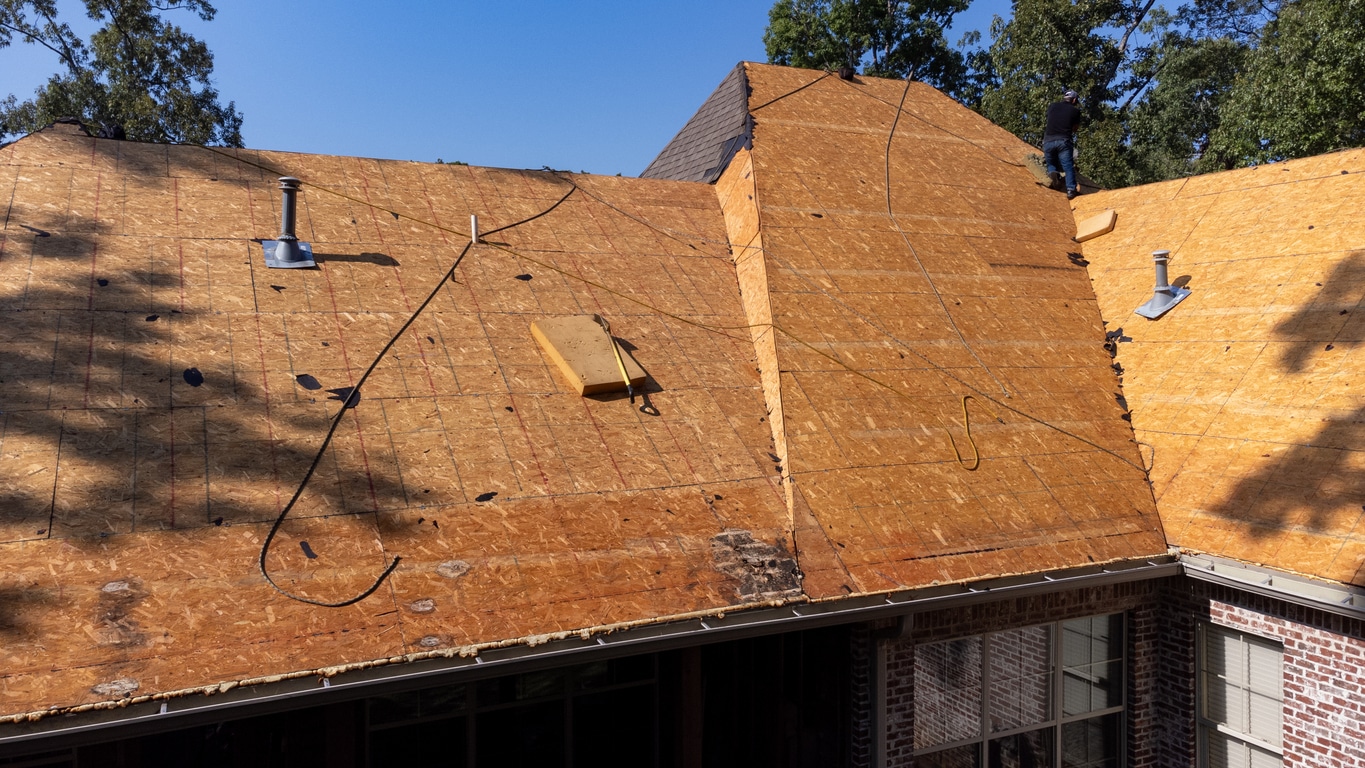
You hear the rain pounding outside and hope your roof will hold, but deep down, you remember the water stains you saw in the attic last month. Maybe you brushed it off, thinking it was nothing serious. After all, your shingles still look fine from the street. What most homeowners don’t realize is that the real strength of a roof lies beneath what you can see. The roof decking, hidden under the shingles, is the backbone of your entire roofing system. When it weakens, everything above it is at risk.
Many families in Atlanta discover problems with their roof decking only after costly damage has already spread inside their homes. From sagging spots to musty odors in the attic, the warning signs are easy to overlook until it is too late.
That is where Mr. Roofer comes in. With years of experience and a commitment to protecting homes across the Atlanta area, our team knows how to spot, repair, and replace compromised roof decking before it threatens your comfort and safety. This guide will help you understand what roof decking is, why it matters, and when it is time to take action.
What Is Roof Decking?
Roof decking, also called roof sheathing, is the foundation layer of your roofing system. It is the structural base that provides a solid surface for shingles, tiles, or roofing membranes to attach to. Typically made from plywood, oriented strand board (OSB), or in some cases older roof planks, roof decking spans across the rafters or trusses of a home to create a continuous surface.
While homeowners often focus on what they can see, the shingles, roof decking plays an equally important role in the overall strength and durability of the roof. Without properly installed and maintained decking, even the highest-quality roofing materials cannot perform as intended.
The choice of roof decking materials and the condition of the decking directly affect not only the roof’s ability to resist leaks and weather damage but also the home’s energy efficiency and indoor comfort. For this reason, understanding what roof decking is and why it matters can help homeowners make better decisions during roof inspections, repairs, or replacements.
What Does Roof Decking Do?
Roof decking is more than just a flat surface beneath the shingles. It connects the rafters or trusses and unifies them into one solid structure, giving the roof its rigidity and strength. Without decking, individual rafters would carry loads unevenly, leaving the roof vulnerable to sagging or failure.
The decking also distributes the weight of roofing materials, snow, and rainwater evenly across the roof system. This distribution prevents isolated stress points that can lead to cracks or collapse over time. In addition, roof decking acts as the anchor point for fasteners, ensuring shingles, underlayment, and membranes stay secure, even in strong winds.
Another critical function of decking is moisture protection. When paired with underlayment, it acts as a barrier that helps prevent water from seeping into the attic or living spaces. This protection not only guards against rot and mold but also preserves the insulation and structural integrity of the home.
In short, roof decking is the silent workhorse of the roofing system, creating a sturdy, weather-resistant base that supports and extends the lifespan of the visible roof covering.
Types of Roof Decking Used in Atlanta Residential Construction
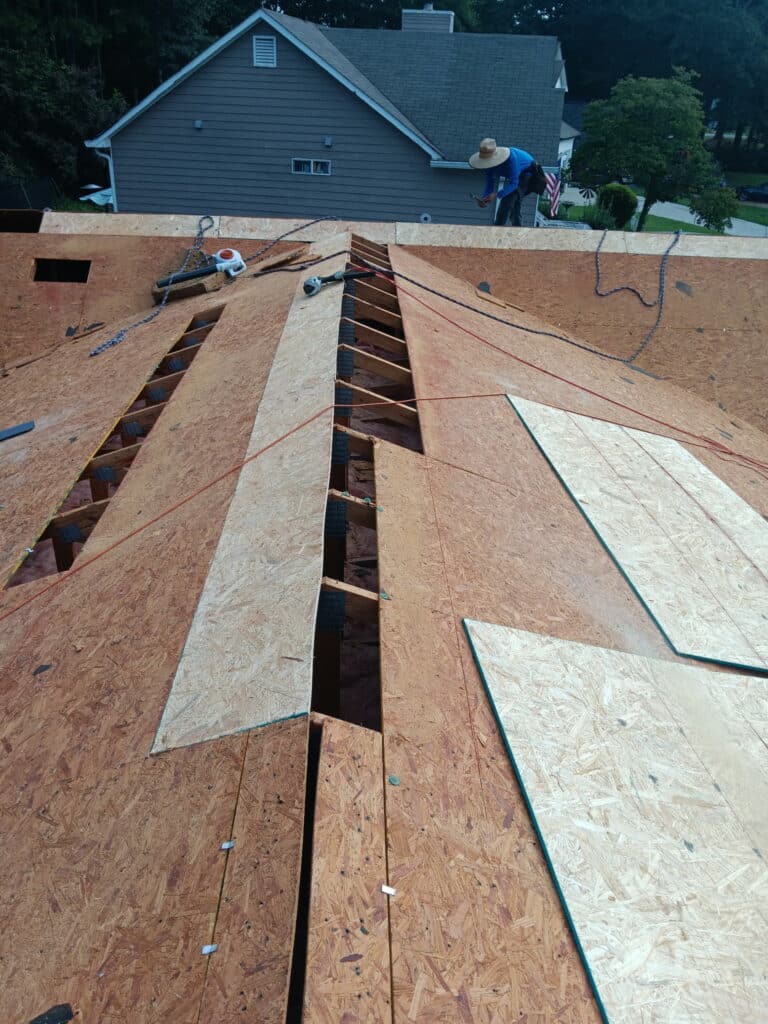
Not all roof decking is the same. Over the decades, construction practices and materials have evolved, leading to different options for homeowners. In Atlanta, you’ll find a mix of traditional and modern decking types depending on when a home was built and what roofing system was chosen. Understanding the strengths and limitations of each helps homeowners anticipate maintenance needs and make informed choices during roof replacements.
Here’s a quick overview of the types of roof decking:
Decking Type | Common Use | Strengths | Limitations | Typical Homes Found In |
Plywood (CDX) | Most modern homes | Durable, holds fasteners well, resists warping | Slightly more costly than OSB | Suburban and newer builds |
OSB (Oriented Strand) | Budget-friendly construction | Affordable, uniform surface, strong | More prone to swelling when exposed to water | Large-scale residential developments |
Plank Decking (1×6/1×8) | Older homes (pre-1970s) | Strong, long-lasting when maintained | Gaps cause code issues, often needs overlays | Historic or mid-century homes |
Tongue-and-Groove | Custom or exposed roof designs | Seamless look, stable, aesthetic appeal | Higher cost, more labor-intensive | Custom, high-end homes |
Plywood (CDX)
CDX plywood is one of the most common roof decking materials used in modern homes. It is made by gluing thin sheets of wood veneer together with the grain alternating in each layer, which gives it strong resistance to bending and warping. The “CDX” designation indicates that one side of the sheet has a rougher surface (C grade) while the other side is smoother (D grade), and the “X” refers to the exterior-grade adhesive used to withstand moisture.
Plywood strikes a balance between cost and performance. It’s:
- Affordable
- Easy to work with
- Durable under typical Atlanta weather conditions
Roofers appreciate it because it holds nails and screws securely, which means shingles or other roofing materials remain firmly attached.
OSB (Oriented Strand Board)
Oriented Strand Board, commonly known as OSB, is another popular decking option. It is created by layering wood strands and bonding them together with resins under heat and pressure. The result is a strong, uniform panel that is more budget-friendly than plywood.
OSB’s even surface makes it ideal for roofing membranes and shingles, and its lower price point makes it attractive for large-scale construction projects. However, OSB is somewhat more vulnerable to moisture compared to plywood. If water penetrates beneath the roofing materials and sits on the decking, OSB can swell along the edges. While this does not always compromise structural performance immediately, it can lead to uneven surfaces and require earlier replacement if moisture issues are persistent.
Plank Decking (1×6 or 1×8 boards)
Many homes in Atlanta built before the 1970s feature plank decking. This method uses individual boards, often 1×6 or 1×8 in size, laid across the rafters to create the roof’s base. Plank decking was a reliable option in its time, and when maintained properly, it still provides a strong foundation for the roofing system.
The challenge with plank decking is that it may not meet modern roofing standards without reinforcement. Because the gaps between boards can be inconsistent, today’s roofing materials sometimes require an additional layer of plywood or OSB over the roof planks to provide a continuous surface. Homeowners with older homes should expect this extra step during roof replacement projects.
Tongue-and-Groove Decking
Tongue-and-groove decking is less common in Atlanta residential construction but is sometimes used for homes with exposed decking designs, such as vaulted ceilings or decorative roof structures. This system features boards that interlock with a tongue on one side and a groove on the other, creating a more seamless and stable surface.
The tight fit helps prevent gaps and increases the overall strength of the roof system. Tongue-and-groove decking also offers aesthetic appeal, making it a practical choice for situations where the underside of the decking is visible from inside the home. However, because it is more labor-intensive and costly, it is typically reserved for custom or high-end projects rather than standard residential roofing.
Signs of Roof Deck Damage
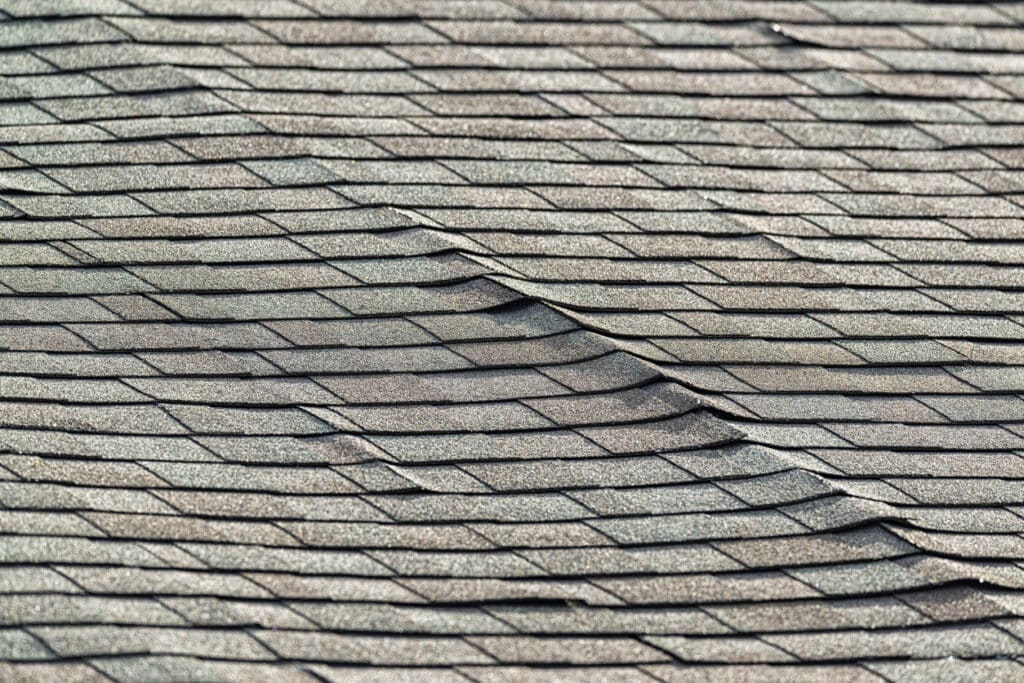
Roof decking is hidden beneath the shingles, which means problems often go unnoticed until they cause visible issues inside or outside the home. Catching signs of damage early can save homeowners from costly roof deck repairs and prevent structural problems from spreading. Below are some of the most common indicators that roof decking may be compromised.
Visible Sagging or Soft Spots
One of the clearest warning signs of deck damage is visible sagging on the roof surface. When decking weakens from water infiltration or rot, it can no longer support the weight of shingles, underlayment, and environmental loads like rain or debris. This weakness causes areas of the roof to dip or appear uneven. Soft spots may also be noticeable from the attic if sections of decking bend under light pressure.
Sagging is not just cosmetic. It signals that the structural integrity of the roof is at risk. If left unaddressed, sagging decking can collapse under heavy rainfall or additional weight, leading to emergency roof deck repairs.
Uneven or Spongy Feel When Walking on Roof
Roofing professionals often identify damaged decking by walking across the roof’s surface. Healthy decking feels solid and stable, while compromised decking can feel uneven, springy, or spongy underfoot. This spongy sensation occurs when the wood fibers inside the decking have broken down due to:
- Moisture
- Rot
- Age
Homeowners should not attempt to test this themselves, as walking on a compromised roof can be dangerous. Instead, it is best to leave this inspection to licensed roofing professionals who have the proper safety equipment and experience.
Roof Leaks or Water Stains in the Attic
Water intrusion is one of the most common causes of roof decking damage. If you notice leaks during rainstorms or water stains spreading across attic rafters and insulation, it is a strong indicator that moisture has penetrated the roof system.
Over time, repeated exposure to water can cause the decking to warp, crack, or lose its ability to hold nails securely. Even small leaks, when left untreated, can lead to widespread decking replacement during a roofing project.
Moldy or Musty Smell
A moldy or musty odor inside the attic often points to hidden moisture problems. Roof decking that remains damp for long periods provides an ideal environment for mold growth. Not only does this weaken the wood, but it also poses health risks to the household by releasing spores into the indoor air.
These smells may appear before any visible mold or water damage is spotted, which is why they should never be ignored. A roofing inspection can determine if the odors are linked to decking damage, poor ventilation, or insulation issues.
Delamination or Swelling of Decking Boards
When plywood or OSB decking absorbs water, the layers within the board can begin to separate, a process known as delamination. Similarly, the edges of OSB can swell when exposed to moisture, creating uneven surfaces that make it difficult for shingles to lay flat.
Delamination and swelling compromise the strength of the decking and shorten the lifespan of the entire roofing system. These problems often remain hidden until old shingles are removed, which is why roofers typically inspect the decking carefully during every replacement project.
Causes of Roof Decking Failure
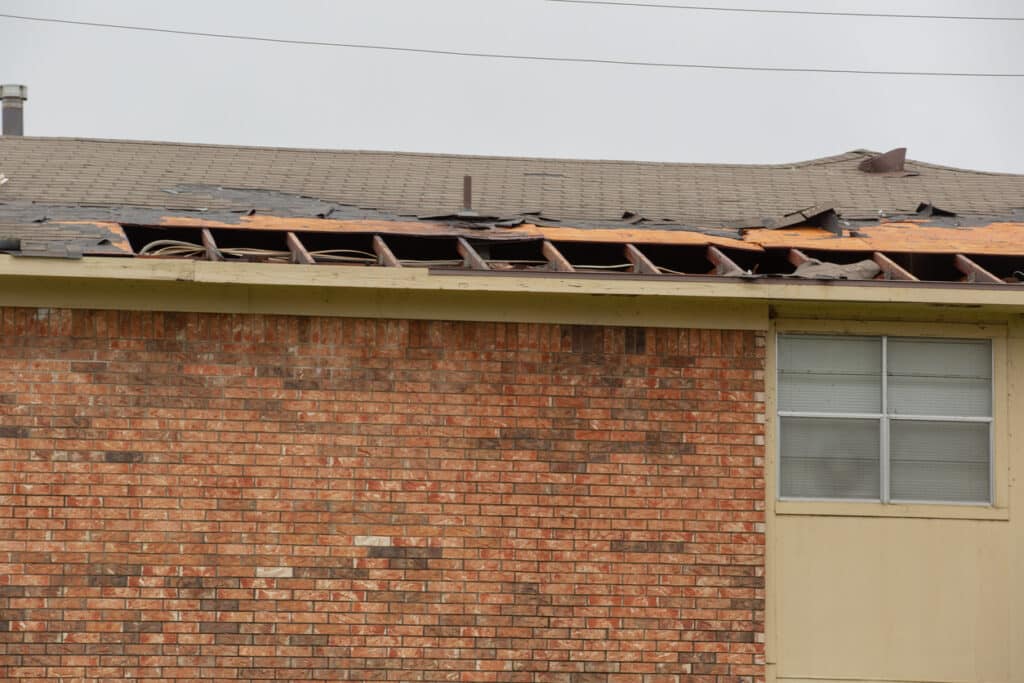
Roof decking is designed to provide decades of service, but several factors can weaken it over time. Some are gradual, such as aging or poor ventilation, while others are sudden, like storm damage. Understanding the most common causes of roof decking failure helps homeowners take proactive steps to protect their investment and extend the life of their roof system.
Water Damage From Roof Leaks
Water intrusion is the leading cause of roof decking failure. When shingles or underlayment are damaged, water can seep beneath the roofing surface and saturate the decking. Prolonged exposure weakens wood fibers, leading to:
- Rot
- Warping,
- Eventual collapse in severe cases
Even small leaks can have significant consequences. Water stains, mold, and soft spots are often the first signs, but by the time these are noticeable, the decking may already be compromised. Regular roof inspections are the best way to catch minor leaks before they evolve into widespread damage.
Improper Attic Ventilation Leading to Condensation
Poor attic ventilation can be just as destructive as a roof leak. Without adequate airflow, warm air from inside the home rises into the attic and condenses on cooler surfaces, including the underside of the decking. Over time, this trapped moisture causes the same deterioration as a leak, leading to mold growth, swelling, and weakening of the decking.
Properly designed ventilation systems balance intake and exhaust vents, allowing air to circulate freely. This not only protects the decking but also improves energy efficiency and reduces the risk of ice dams in colder climates.
Age-Related Wear in Plank Roof Decking
Homes with older plank-style decking, often built before the 1970s, are more prone to age-related wear. The natural expansion and contraction of wood over decades can create gaps between roof planks, making the roof less stable. Planks may also split, crack, or shift out of place, leaving uneven surfaces that are unsuitable for modern roofing systems.
During roof replacements, contractors often reinforce older plank decking with a layer of plywood or OSB. This upgrade provides a smooth, continuous surface that meets current building standards and improves the durability of the new roof.
Inadequate Support or Improper Installation
In some cases, roof decking failure can be traced back to poor installation. If decking boards are not properly spaced, fastened, or supported, the roof may develop weak points. These weaknesses become more pronounced under heavy loads, such as after a storm or snowfall.
Using the wrong thickness of roof decking material can also cause premature failure. For example, thinner panels may sag between rafters over time. Choosing the correct materials and ensuring they are installed to code is critical for a long-lasting roof system.
Storm Damage (Wind-Driven Rain, Hail, Tree Limbs)
Severe weather events in Atlanta, such as thunderstorms, hailstorms, or strong winds, can cause sudden damage to roof decking. Wind-driven rain may force water under shingles, while hail can crack shingles and expose the decking below. Falling tree limbs pose an even greater risk, often breaking through the roofing surface and directly damaging the structural base.
Even if storm damage seems minor from the outside, the decking beneath could still be compromised. A professional inspection after major weather events is essential to ensure the decking remains sound and the roof system continues to protect the home effectively.
How Roof Decking Impacts the Entire Roofing System
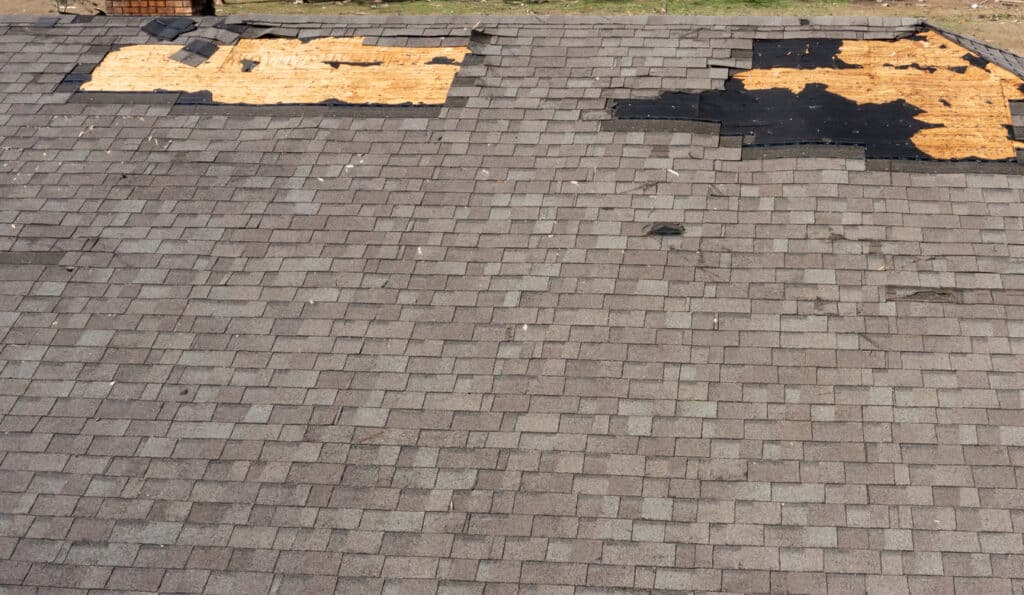
Roof decking is not just another hidden layer under shingles. It is the foundation that determines how well the entire roof system performs over time. When the decking is strong and properly installed, roofing materials can do their job effectively. But when the decking is compromised, every other component of the roof is put at risk.
Shingles Rely on Solid Decking for Proper Fastening
Shingles are only as secure as the surface they are nailed into. Solid decking provides the necessary holding power for fasteners, keeping shingles anchored against:
- Wind
- Rain
- Daily wear
If decking becomes soft, rotted, or delaminated, nails can loosen or pull out entirely, allowing shingles to shift or blow away. This creates openings for leaks and can shorten the lifespan of the roof dramatically.
Decking Determines How Long Roofing Materials Perform
Even the highest-quality shingles or membranes cannot perform as intended on weak or uneven decking. Warped surfaces prevent shingles from lying flat, creating gaps that allow wind-driven rain to penetrate. Moisture trapped beneath uneven materials accelerates deterioration, meaning homeowners who invest in premium roofing products may still face premature failure if the decking below is not sound.
Warped or Rotted Decking Reduces Energy Efficiency and Increases Leak Risk
Healthy decking helps maintain a continuous barrier against outside air and water. When decking warps, cracks, or rots, it creates pathways for heat loss in winter and heat gain in summer, raising energy bills and making indoor temperatures harder to control. At the same time, damaged decking increases the likelihood of leaks by weakening the protective layers above it. These combined issues put both comfort and structural safety at risk.
A Weak Deck Can Void Roofing Warranties
Manufacturers understand how critical decking is to the performance of a roofing system. Many warranty programs, including those offered by brands like GAF, require roofs to be installed over code-compliant decking. If the underlying structure is not sound, warranties may be voided, leaving homeowners without protection in the event of a failure. Ensuring proper decking during a roof replacement is not just about durability, it is also about protecting the homeowner’s investment.
Repairing or Replacing Roof Decking
Addressing roof decking issues is a critical part of maintaining a safe and reliable roofing system. In some cases, simple roof deck repairs are enough to restore strength, but in others, full replacement is the only way to ensure long-term performance. Knowing the difference helps homeowners make informed choices and avoid unnecessary costs while still protecting their homes.
Situation | Repair Possible? | Replacement Needed? | Notes |
Small localized soft spots | Yes | No | Replace affected boards or sections |
Isolated plank damage | Yes | No | Works with older plank decking |
Widespread rot or water damage | No | Yes | Full replacement ensures structural integrity |
Gaps in plank decking | No | Yes | Overlay with plywood or OSB for modern standards |
Multiple roofing layers present | No | Yes | Excess weight requires tear-off and new decking |
When Roof Deck Repairs Are Enough
Not every problem with roof decking requires a full tear-out. Small, localized soft spots caused by minor leaks can often be repaired by removing the damaged section and replacing it with new wood. This approach works well when the majority of the decking remains sound.
In homes with older plank-style decking, it is also possible to replace individual boards without redoing the entire roof base. For instance, if only a few roof planks are cracked or rotted, a contractor can remove and swap them with new 1×6 or 1×8 boards. This kind of targeted roof deck repair is often compatible with asphalt shingle overlay projects, where the existing roof covering is being replaced without stripping down to the rafters.
When Replacement Is Required
Full decking replacement becomes necessary when the damage is widespread or when the structure no longer meets modern building codes. If water intrusion has caused large areas of rot or delamination, patchwork repairs will not provide long-term stability. In these cases, new plywood or OSB must be installed across the roof.
Another common reason for replacement is code compliance. Older homes with plank decking often have gaps between boards that make them unsuitable for direct shingle installation. Building codes in many areas, including Atlanta, require a solid and continuous surface, which means overlaying or replacing with modern materials.
Additionally, homes with multiple layers of roofing may put extra stress on the decking. The combined weight can cause older materials to sag or fail, leaving replacement as the safest and most durable option.
Process Overview
Repairing or replacing roof decking typically follows a clear sequence that ensures both safety and quality:
- Tear-off of roofing materials – Roofers remove shingles, underlayment, and other coverings to expose the decking.
- Deck inspection – Each section of decking is carefully checked for rot, warping, gaps, or signs of water damage.
- Replace or overlay with plywood/OSB – Damaged sections are swapped out, or in cases of older plank decking, a new layer of plywood or OSB may be installed on top.
- Underlayment and new roofing installed – Once the decking is solid, roofers add a protective underlayment before laying down shingles or other roofing materials.
This process ensures that the roof has a stable foundation, which not only improves performance but also protects the home against future damage.
Roofing Code & Inspection Requirements in Georgia
Roof decking is not only a structural element of the roofing system, it is also regulated by building codes that ensure safety and long-term performance. In Georgia, local jurisdictions such as Marietta, Alpharetta, and many Atlanta suburbs enforce specific requirements that homeowners should be aware of before starting a roofing project. Ignoring these standards can lead to failed inspections, voided warranties, or even fines.
Requirement | Georgia Standard/Practice | Why It Matters |
Deck thickness and spacing | Minimum 7/16-inch plywood or OSB, proper spacing | Prevents buckling, ensures long-term strength |
Maximum roofing layers allowed | Two layers | Avoids excessive weight and hidden damage |
Permits for reroofing with decking work | Typically required in Marietta, Alpharetta, Atlanta | Ensures compliance, avoids failed inspections |
Inspection focus areas | Deck thickness, fastener spacing, ventilation | Confirms structural integrity and code compliance |
Deck Thickness and Spacing Requirements
Most metro Atlanta municipalities, including Marietta and Alpharetta, follow the International Residential Code (IRC) with local amendments. These codes require roof decking to meet minimum thickness standards based on rafter spacing and the type of roofing material installed. For example, plywood and OSB panels are often required to be at least 7/16-inch thick when rafters are spaced 24 inches on center, though thicker roof decking materials may be recommended for added durability.
Improper spacing between decking sheets or planks is also prohibited. Gaps that are too wide can compromise shingle performance, while insufficient spacing can lead to buckling when the wood expands in humid weather. Meeting these requirements ensures that the roof not only passes inspection but also performs reliably for years.
Limits on Roofing Layers
Georgia building codes generally restrict homes to no more than two layers of roofing over existing decking. This regulation protects the structure from bearing excessive weight and ensures that hidden damage is not overlooked. For example, if an older roof already has two layers of shingles, contractors must perform a complete tear-off down to the decking before installing a new roof.
This rule is especially important in Atlanta’s climate, where heavy rain and high humidity can accelerate decking deterioration. Allowing too many layers would prevent contractors from spotting rotted wood or water damage that needs to be repaired before a new roof is installed.
Permits and Inspection Requirements
In most Georgia jurisdictions, a permit is required for reroofing projects that involve decking repairs or replacement. The permitting process ensures that licensed contractors perform the work according to code and that city or county inspectors verify compliance at key stages of the project.
Inspections often focus on confirming:
- Proper deck thickness
- Correct fastener spacing
- Integrity of the roof decking materials used
In cases where decking replacement is extensive, inspectors may also review ventilation and underlayment installation to confirm that the entire roofing system meets safety and performance standards.
For homeowners, understanding these requirements is essential. Failing to obtain a permit or pass inspection could delay the project, increase costs, or complicate insurance claims in the future. Partnering with a certified roofing contractor helps ensure that every step of the process meets Georgia’s standards.
Conclusion
Roof decking may be hidden beneath shingles, but it is the foundation that holds your entire roofing system together. From supporting shingles and protecting against leaks to meeting Georgia’s building codes, a strong and well-maintained deck is what ensures your roof can stand up to Atlanta’s weather year after year. Ignoring signs of damage or cutting corners during installation can put your home, your comfort, and even your warranty at risk.
Whether your home needs small roof deck repairs, a complete decking replacement, or a thorough inspection after storm damage, having the right roofing partner makes all the difference. Mr. Roofer has decades of experience helping Atlanta-area homeowners protect their investment with expert roof decking repair and replacement services. Our team knows the local codes, understands the unique needs of Georgia homes, and is committed to delivering long-lasting solutions that give you peace of mind.
Don’t wait until minor issues become costly repairs. Contact Mr. Roofer today to schedule your roof inspection and ensure your home rests on a strong foundation that will protect your family for years to come.
